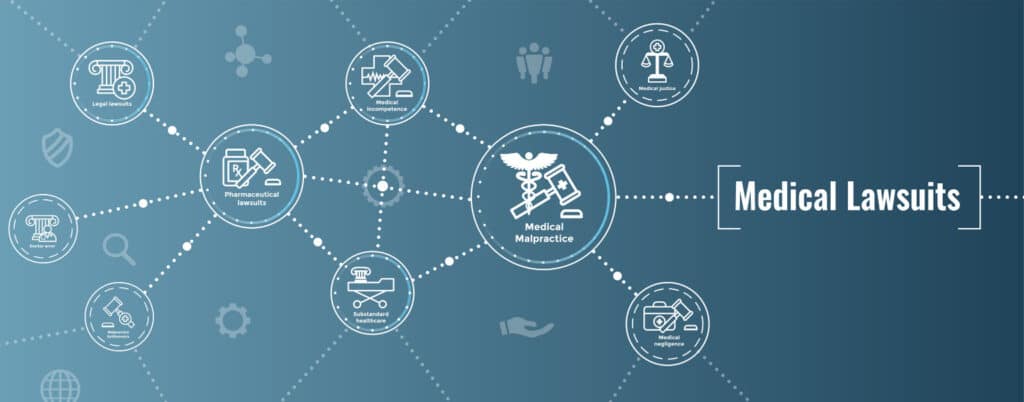Medical malpractice is a form of negligence that occurs when a medical professional, such as a doctor, nurse, or other health care provider, fails to provide the standard of care that is expected of them. It is important to note that there is a statute of limitations on medical malpractice cases, meaning that if an individual waits too long to file their case they may be unable to pursue it. In this article, we will explore what medical malpractice is, the types of medical malpractice, what is involved in a medical malpractice case, and five common examples of medical malpractice.
What is Medical Malpractice?
Medical malpractice, also known as medical negligence, occurs when a healthcare professional fails to provide a standard level of care and causes harm to a patient. There are several types of medical malpractice, including misdiagnosis, surgical errors, birth injuries, and medication errors. In order to win a medical malpractice lawsuit, a patient must prove that the healthcare professional had a duty to provide a certain level of care, that this duty was breached, and that the breach caused harm to the patient.

The Types of Medical Malpractice
There are multiple types of medical malpractice and how healthcare professionals can harm their patients. Here are some common types of medical malpractice below.
- Misdiagnosis: This occurs when a healthcare professional fails to correctly diagnose a patient’s condition, leading to delayed or incorrect treatment.
- Surgical errors: These can include performing the wrong procedure, performing a procedure on the wrong body part, or leaving surgical instruments or other materials inside the patient’s body after surgery.
- Birth injuries: These can include injuries to the baby, such as cerebral palsy, as well as injuries to the mother, such as a ruptured uterus.
- Medication errors: These can include prescribing the wrong medication, giving the wrong dosage, or failing to properly monitor the patient for side effects.
- Anesthesia errors: These can include administering too much or too little anesthesia, failing to properly monitor the patient during surgery, or failing to properly manage a patient’s pain after surgery.
- Delayed diagnosis: This occurs when a healthcare professional fails to diagnose a patient’s condition in a timely manner, leading to a worse outcome.
- Failure to obtain informed consent: This occurs when a healthcare professional fails to obtain a patient’s informed consent before performing a procedure or treatment.
- Failure to properly monitor a patient: This occurs when a healthcare professional fails to properly monitor a patient’s condition, leading to delayed or incorrect treatment.
It is important to note that not all cases of medical errors are considered medical malpractice. To be considered malpractice, the mistake must have occurred due to a failure to provide a standard level of care and caused harm to the patient.

What A Medical Malpractice Case Involves
A medical malpractice case typically involves the following steps:
- Gathering evidence: The patient (or their attorney) will gather evidence such as medical records, witness statements, and expert testimony to support their claim that the healthcare professional failed to provide a standard level of care.
- Filing a complaint: The patient (or their attorney) will file a complaint with the appropriate state agency or court. The complaint will typically include a detailed description of the alleged medical malpractice and the damages suffered by the patient.
- Discovery: This is the process of gathering information from the other side (the healthcare professional and/or their insurance company) in the case. This can include taking depositions (sworn statements) from the healthcare professional and other witnesses, and requesting documents and other evidence.
- Expert testimony: Expert testimony is often used in medical malpractice cases to help the jury understand the standard of care that should have been provided and whether the healthcare professional’s actions met that standard.
- Settlement negotiations: In many cases, the healthcare professional’s insurance company will offer a settlement to the patient in order to avoid the costs and uncertainty of a trial. If a settlement is reached, the case will be resolved without going to trial.
- Trial: If a settlement cannot be reached, the case will go to trial. The patient will present their evidence and witnesses, and the healthcare professional will present their defense. A jury will then decide whether the healthcare professional is liable for medical malpractice and, if so, what damages the patient should be awarded.
It is important to note that the process and the outcome of a medical malpractice case can vary depending on the specific circumstances and jurisdiction. It is always recommended to seek the advice of an experienced medical malpractice attorney to understand your rights and options.
5 Common Examples of Medical Malpractice
There are multiple examples of ways healthcare professionals can harm patients due to errors. Here’s a look some examples of medical malpractice.
- Misdiagnosis: A healthcare professional fails to correctly diagnose a patient’s condition, leading to delayed or incorrect treatment. For example, a patient with cancer may be misdiagnosed as having a less serious condition, delaying the start of appropriate treatment and potentially leading to a worse outcome.
- Surgical errors: A healthcare professional performs the wrong procedure, performs a procedure on the wrong body part, or leaves surgical instruments or other materials inside the patient’s body after surgery. These errors can lead to serious complications, such as infections, organ damage, and even death.
- Birth injuries: A healthcare professional fails to properly monitor the mother and baby during delivery, or fails to perform a necessary cesarean section leading to injuries to the baby, such as cerebral palsy, or injuries to the mother, such as a ruptured uterus.
- Medication errors: A healthcare professional prescribes the wrong medication, gives the wrong dosage, or fails to properly monitor the patient for side effects. These errors can lead to serious harm, such as organ damage, allergic reactions, and even death.
- Anesthesia errors: A healthcare professional administers too much or too little anesthesia, fails to properly monitor the patient during surgery, or fails to properly manage a patient’s pain after surgery. This can lead to serious complications such as brain damage, organ failure, and even death.
It is important to note that the above examples are not an exhaustive list, and not all cases of medical errors are considered medical malpractice.

What Needs to be Proved to Win A Medical Malpractice Lawsuit
In order to win a medical malpractice lawsuit, a patient (or their legal representative) must prove the following elements:
- Duty of care: The patient must show that the healthcare professional had a duty to provide a certain level of care to the patient. This duty is established by the professional-patient relationship.
- Breach of duty: The patient must show that the healthcare professional failed to meet the standard of care that was expected of them. This can be done by presenting evidence of the healthcare professional’s actions or lack thereof and how they deviated from the standard of care.
- Causation: The patient must show that the healthcare professional’s breach of duty caused harm to the patient. This requires linking the healthcare professional’s actions or lack thereof to the harm suffered by the patient.
- Damages: The patient must show that they suffered actual harm, such as physical injury, emotional distress, or economic loss, as a result of the healthcare professional’s breach of duty.
It is important to note that the standard of care may vary depending on the specific circumstances and jurisdiction. It is always recommended to seek the advice of an experienced medical malpractice attorney to understand your rights and options and to navigate the legal process.
Final Words About Medical Malpractice
Medical malpractice is a serious issue that can have far-reaching consequences for those affected. It is important to understand the different types of medical malpractice, what a medical malpractice case involves, and 5 common examples of medical malpractice. Furthermore, it is also essential to know what needs to be proved in order to win a medical malpractice lawsuit.
It is important to remember that if you or someone you love has suffered harm due to medical negligence, then you may have legal recourse. Therefore, it is highly recommended that you contact an experienced medical malpractice attorney to discuss the details of your case. A qualified medical malpractice lawyer will be able to help you better understand your legal rights and options, as well as provide valuable advice on how best to proceed with your case.
Medical malpractice cases can be complex and time-consuming, but with the right legal representation and preparation, victims of medical negligence may be able to recover the damages they deserve.





